Corporate Accounting Report: Debenhams Plc. Capital Structure
VerifiedAdded on 2023/06/05
|19
|5122
|69
Report
AI Summary
This report provides a comprehensive analysis of Debenhams Plc.'s corporate accounting practices, focusing on shareholder wealth maximization versus other objectives like risk minimization and stakeholder models. It explores the company's external financing sources, including equity and debt, and examines the factors influencing these choices. The report delves into Debenhams Plc.'s financial performance, presenting key metrics and capital structure details. It also covers the concept of the weighted average cost of capital (WACC) and its application to the company, including a discussion of relevant factors and practical considerations. The report concludes with recommendations regarding the company's capital structure and overall financial strategy.
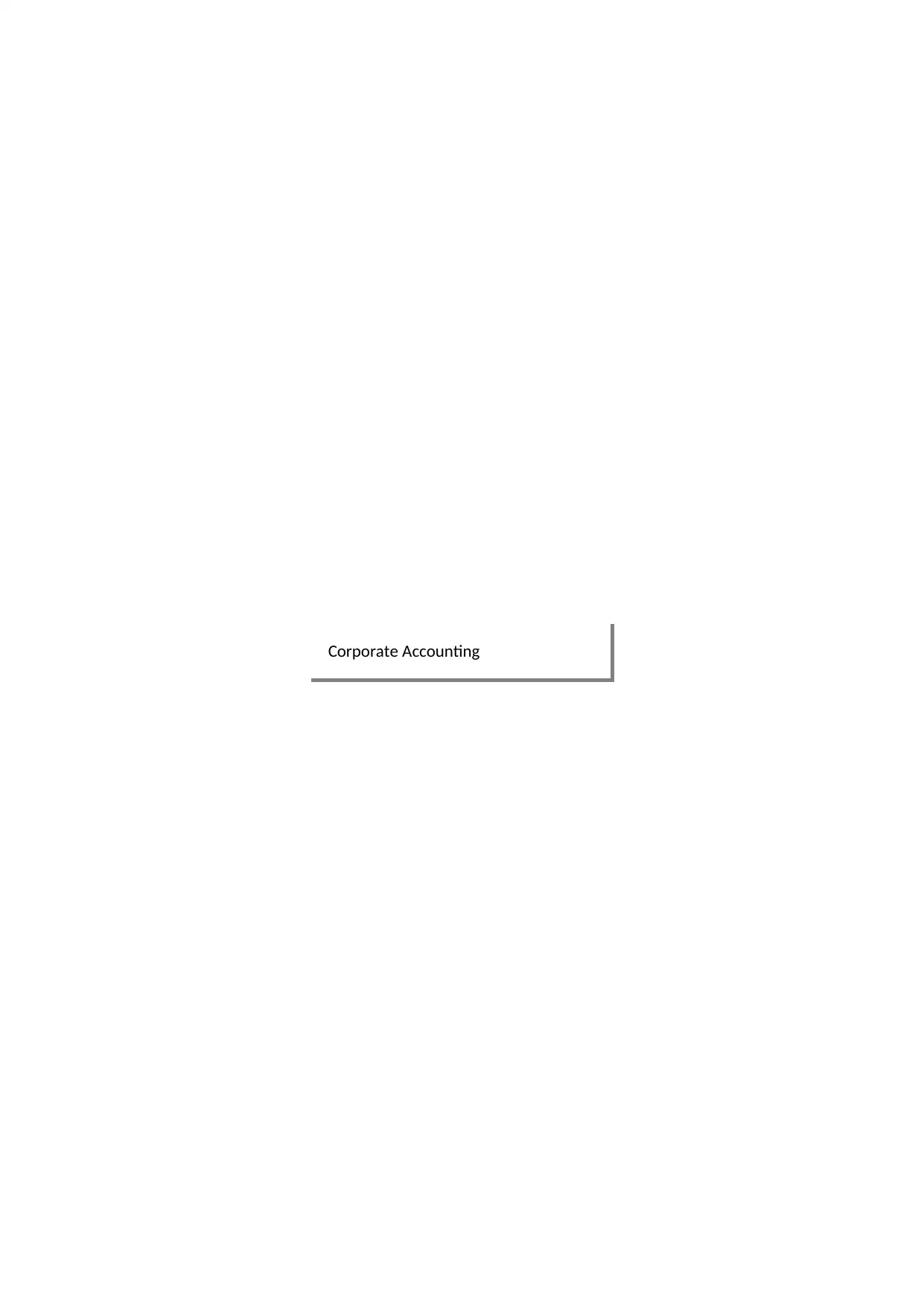
Corporate Accounting
Paraphrase This Document
Need a fresh take? Get an instant paraphrase of this document with our AI Paraphraser
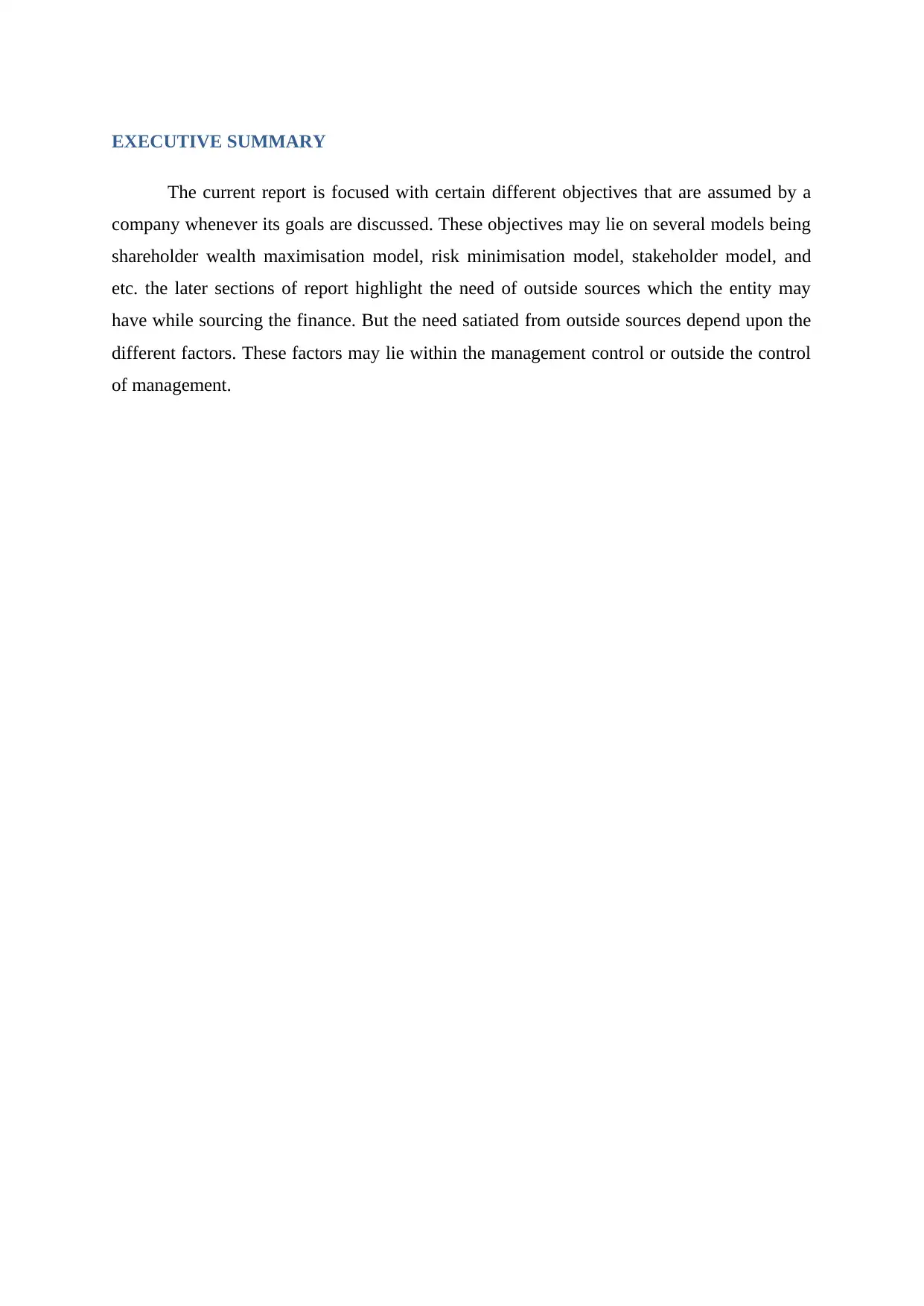
EXECUTIVE SUMMARY
The current report is focused with certain different objectives that are assumed by a
company whenever its goals are discussed. These objectives may lie on several models being
shareholder wealth maximisation model, risk minimisation model, stakeholder model, and
etc. the later sections of report highlight the need of outside sources which the entity may
have while sourcing the finance. But the need satiated from outside sources depend upon the
different factors. These factors may lie within the management control or outside the control
of management.
The current report is focused with certain different objectives that are assumed by a
company whenever its goals are discussed. These objectives may lie on several models being
shareholder wealth maximisation model, risk minimisation model, stakeholder model, and
etc. the later sections of report highlight the need of outside sources which the entity may
have while sourcing the finance. But the need satiated from outside sources depend upon the
different factors. These factors may lie within the management control or outside the control
of management.
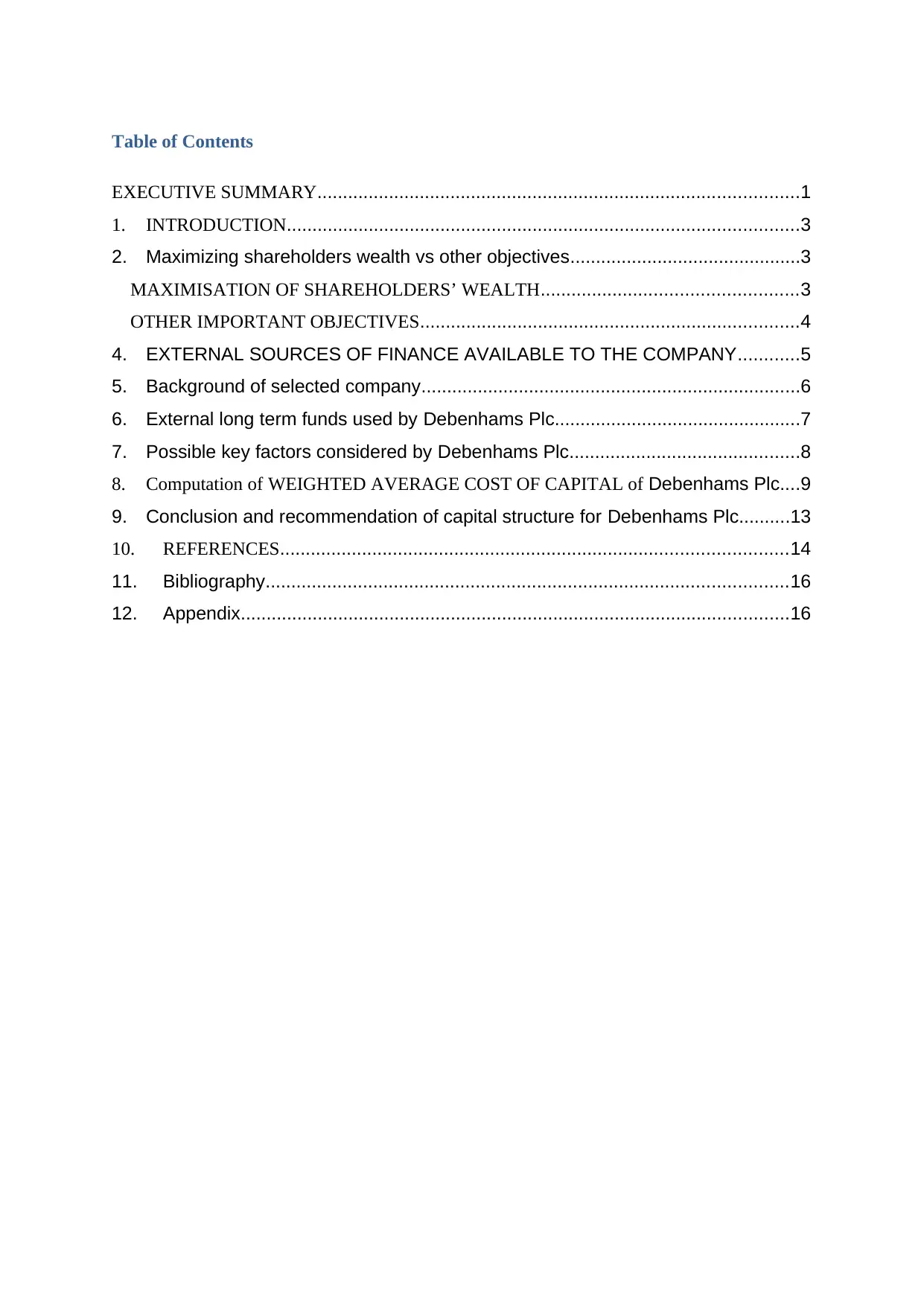
Table of Contents
EXECUTIVE SUMMARY..............................................................................................1
1. INTRODUCTION....................................................................................................3
2. Maximizing shareholders wealth vs other objectives.............................................3
MAXIMISATION OF SHAREHOLDERS’ WEALTH..................................................3
OTHER IMPORTANT OBJECTIVES..........................................................................4
4. EXTERNAL SOURCES OF FINANCE AVAILABLE TO THE COMPANY............5
5. Background of selected company..........................................................................6
6. External long term funds used by Debenhams Plc................................................7
7. Possible key factors considered by Debenhams Plc.............................................8
8. Computation of WEIGHTED AVERAGE COST OF CAPITAL of Debenhams Plc....9
9. Conclusion and recommendation of capital structure for Debenhams Plc..........13
10. REFERENCES...................................................................................................14
11. Bibliography......................................................................................................16
12. Appendix...........................................................................................................16
EXECUTIVE SUMMARY..............................................................................................1
1. INTRODUCTION....................................................................................................3
2. Maximizing shareholders wealth vs other objectives.............................................3
MAXIMISATION OF SHAREHOLDERS’ WEALTH..................................................3
OTHER IMPORTANT OBJECTIVES..........................................................................4
4. EXTERNAL SOURCES OF FINANCE AVAILABLE TO THE COMPANY............5
5. Background of selected company..........................................................................6
6. External long term funds used by Debenhams Plc................................................7
7. Possible key factors considered by Debenhams Plc.............................................8
8. Computation of WEIGHTED AVERAGE COST OF CAPITAL of Debenhams Plc....9
9. Conclusion and recommendation of capital structure for Debenhams Plc..........13
10. REFERENCES...................................................................................................14
11. Bibliography......................................................................................................16
12. Appendix...........................................................................................................16
⊘ This is a preview!⊘
Do you want full access?
Subscribe today to unlock all pages.

Trusted by 1+ million students worldwide
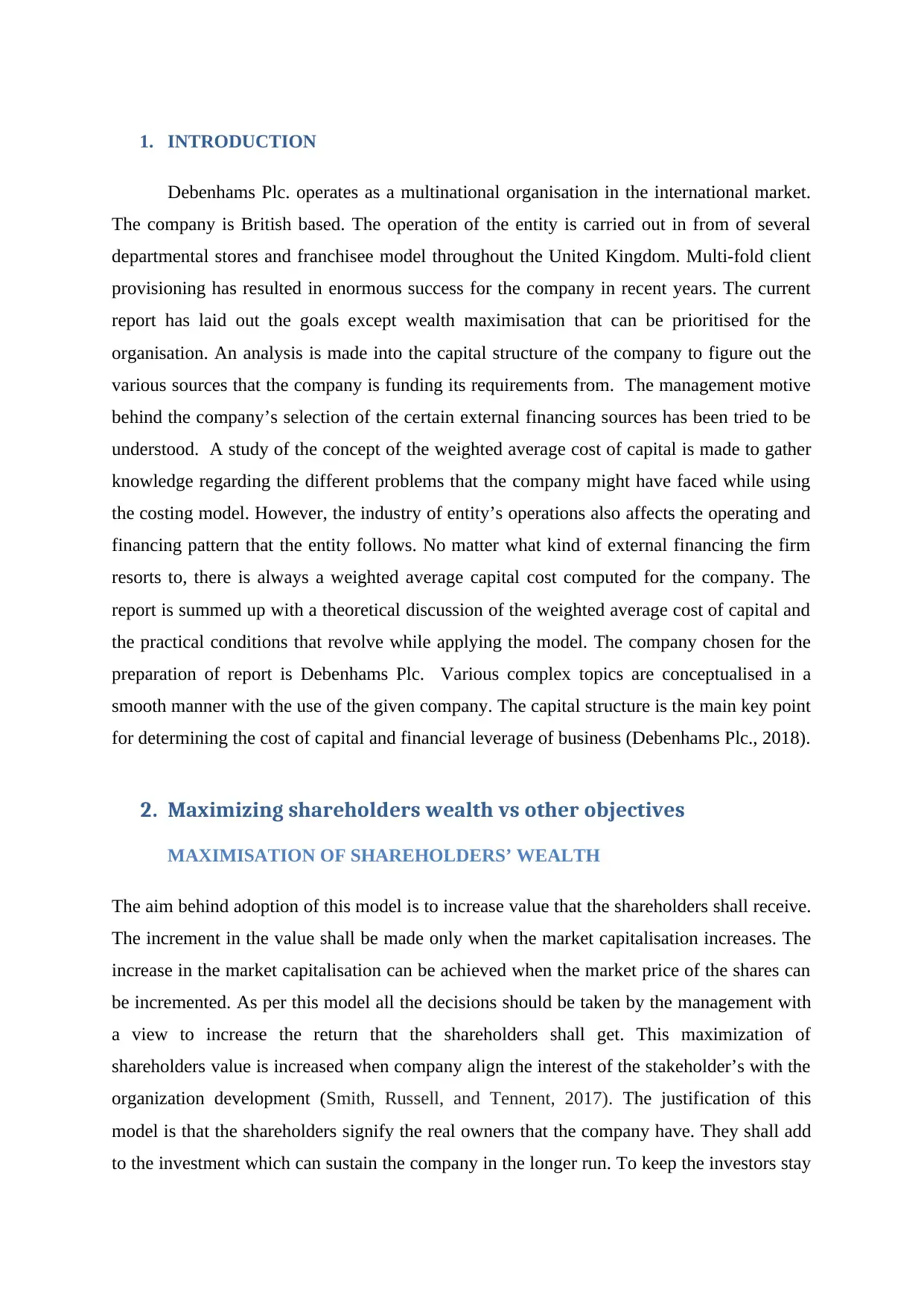
1. INTRODUCTION
Debenhams Plc. operates as a multinational organisation in the international market.
The company is British based. The operation of the entity is carried out in from of several
departmental stores and franchisee model throughout the United Kingdom. Multi-fold client
provisioning has resulted in enormous success for the company in recent years. The current
report has laid out the goals except wealth maximisation that can be prioritised for the
organisation. An analysis is made into the capital structure of the company to figure out the
various sources that the company is funding its requirements from. The management motive
behind the company’s selection of the certain external financing sources has been tried to be
understood. A study of the concept of the weighted average cost of capital is made to gather
knowledge regarding the different problems that the company might have faced while using
the costing model. However, the industry of entity’s operations also affects the operating and
financing pattern that the entity follows. No matter what kind of external financing the firm
resorts to, there is always a weighted average capital cost computed for the company. The
report is summed up with a theoretical discussion of the weighted average cost of capital and
the practical conditions that revolve while applying the model. The company chosen for the
preparation of report is Debenhams Plc. Various complex topics are conceptualised in a
smooth manner with the use of the given company. The capital structure is the main key point
for determining the cost of capital and financial leverage of business (Debenhams Plc., 2018).
2. Maximizing shareholders wealth vs other objectives
MAXIMISATION OF SHAREHOLDERS’ WEALTH
The aim behind adoption of this model is to increase value that the shareholders shall receive.
The increment in the value shall be made only when the market capitalisation increases. The
increase in the market capitalisation can be achieved when the market price of the shares can
be incremented. As per this model all the decisions should be taken by the management with
a view to increase the return that the shareholders shall get. This maximization of
shareholders value is increased when company align the interest of the stakeholder’s with the
organization development (Smith, Russell, and Tennent, 2017). The justification of this
model is that the shareholders signify the real owners that the company have. They shall add
to the investment which can sustain the company in the longer run. To keep the investors stay
Debenhams Plc. operates as a multinational organisation in the international market.
The company is British based. The operation of the entity is carried out in from of several
departmental stores and franchisee model throughout the United Kingdom. Multi-fold client
provisioning has resulted in enormous success for the company in recent years. The current
report has laid out the goals except wealth maximisation that can be prioritised for the
organisation. An analysis is made into the capital structure of the company to figure out the
various sources that the company is funding its requirements from. The management motive
behind the company’s selection of the certain external financing sources has been tried to be
understood. A study of the concept of the weighted average cost of capital is made to gather
knowledge regarding the different problems that the company might have faced while using
the costing model. However, the industry of entity’s operations also affects the operating and
financing pattern that the entity follows. No matter what kind of external financing the firm
resorts to, there is always a weighted average capital cost computed for the company. The
report is summed up with a theoretical discussion of the weighted average cost of capital and
the practical conditions that revolve while applying the model. The company chosen for the
preparation of report is Debenhams Plc. Various complex topics are conceptualised in a
smooth manner with the use of the given company. The capital structure is the main key point
for determining the cost of capital and financial leverage of business (Debenhams Plc., 2018).
2. Maximizing shareholders wealth vs other objectives
MAXIMISATION OF SHAREHOLDERS’ WEALTH
The aim behind adoption of this model is to increase value that the shareholders shall receive.
The increment in the value shall be made only when the market capitalisation increases. The
increase in the market capitalisation can be achieved when the market price of the shares can
be incremented. As per this model all the decisions should be taken by the management with
a view to increase the return that the shareholders shall get. This maximization of
shareholders value is increased when company align the interest of the stakeholder’s with the
organization development (Smith, Russell, and Tennent, 2017). The justification of this
model is that the shareholders signify the real owners that the company have. They shall add
to the investment which can sustain the company in the longer run. To keep the investors stay
Paraphrase This Document
Need a fresh take? Get an instant paraphrase of this document with our AI Paraphraser
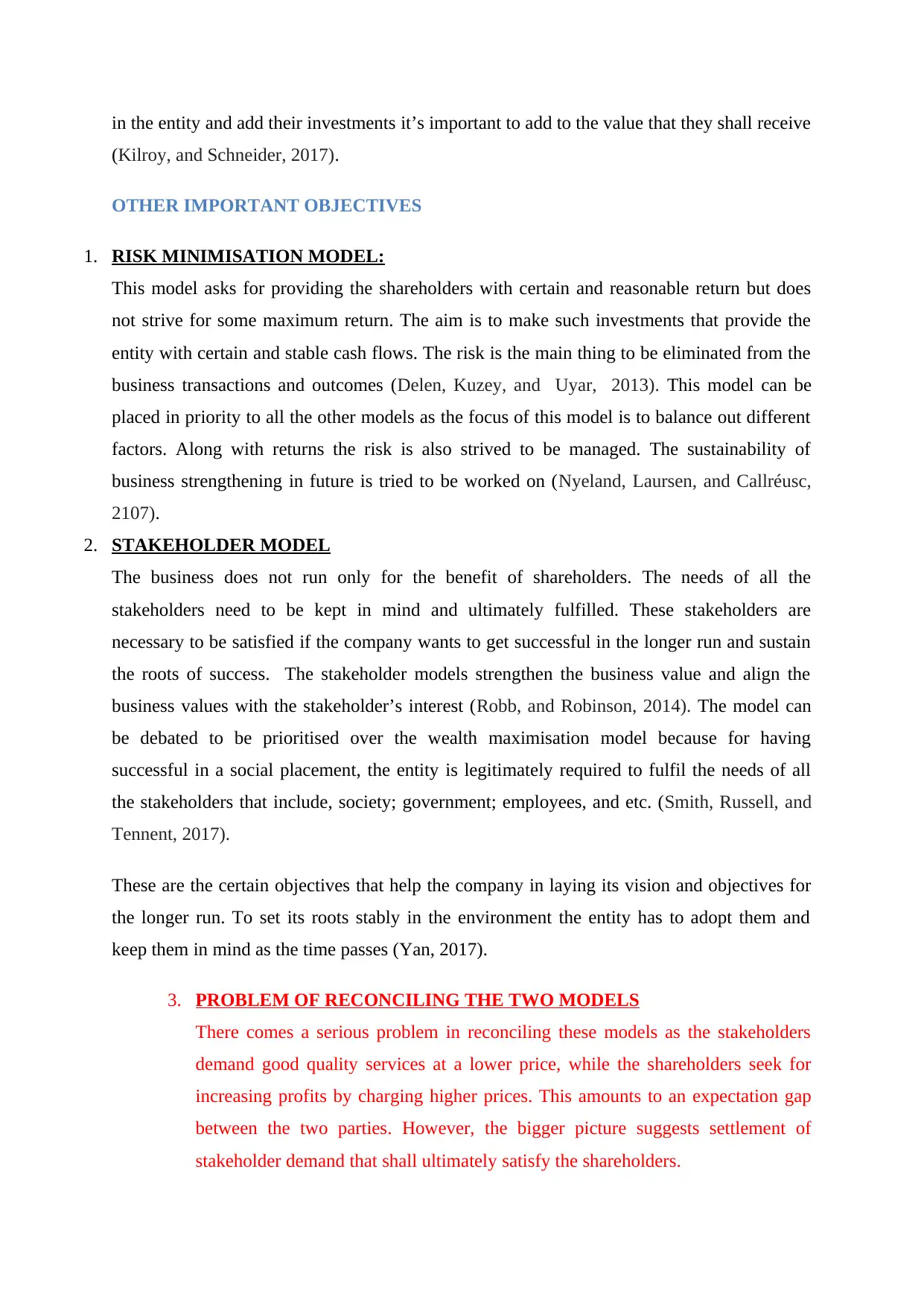
in the entity and add their investments it’s important to add to the value that they shall receive
(Kilroy, and Schneider, 2017).
OTHER IMPORTANT OBJECTIVES
1. RISK MINIMISATION MODEL:
This model asks for providing the shareholders with certain and reasonable return but does
not strive for some maximum return. The aim is to make such investments that provide the
entity with certain and stable cash flows. The risk is the main thing to be eliminated from the
business transactions and outcomes (Delen, Kuzey, and Uyar, 2013). This model can be
placed in priority to all the other models as the focus of this model is to balance out different
factors. Along with returns the risk is also strived to be managed. The sustainability of
business strengthening in future is tried to be worked on (Nyeland, Laursen, and Callréusc,
2107).
2. STAKEHOLDER MODEL
The business does not run only for the benefit of shareholders. The needs of all the
stakeholders need to be kept in mind and ultimately fulfilled. These stakeholders are
necessary to be satisfied if the company wants to get successful in the longer run and sustain
the roots of success. The stakeholder models strengthen the business value and align the
business values with the stakeholder’s interest (Robb, and Robinson, 2014). The model can
be debated to be prioritised over the wealth maximisation model because for having
successful in a social placement, the entity is legitimately required to fulfil the needs of all
the stakeholders that include, society; government; employees, and etc. (Smith, Russell, and
Tennent, 2017).
These are the certain objectives that help the company in laying its vision and objectives for
the longer run. To set its roots stably in the environment the entity has to adopt them and
keep them in mind as the time passes (Yan, 2017).
3. PROBLEM OF RECONCILING THE TWO MODELS
There comes a serious problem in reconciling these models as the stakeholders
demand good quality services at a lower price, while the shareholders seek for
increasing profits by charging higher prices. This amounts to an expectation gap
between the two parties. However, the bigger picture suggests settlement of
stakeholder demand that shall ultimately satisfy the shareholders.
(Kilroy, and Schneider, 2017).
OTHER IMPORTANT OBJECTIVES
1. RISK MINIMISATION MODEL:
This model asks for providing the shareholders with certain and reasonable return but does
not strive for some maximum return. The aim is to make such investments that provide the
entity with certain and stable cash flows. The risk is the main thing to be eliminated from the
business transactions and outcomes (Delen, Kuzey, and Uyar, 2013). This model can be
placed in priority to all the other models as the focus of this model is to balance out different
factors. Along with returns the risk is also strived to be managed. The sustainability of
business strengthening in future is tried to be worked on (Nyeland, Laursen, and Callréusc,
2107).
2. STAKEHOLDER MODEL
The business does not run only for the benefit of shareholders. The needs of all the
stakeholders need to be kept in mind and ultimately fulfilled. These stakeholders are
necessary to be satisfied if the company wants to get successful in the longer run and sustain
the roots of success. The stakeholder models strengthen the business value and align the
business values with the stakeholder’s interest (Robb, and Robinson, 2014). The model can
be debated to be prioritised over the wealth maximisation model because for having
successful in a social placement, the entity is legitimately required to fulfil the needs of all
the stakeholders that include, society; government; employees, and etc. (Smith, Russell, and
Tennent, 2017).
These are the certain objectives that help the company in laying its vision and objectives for
the longer run. To set its roots stably in the environment the entity has to adopt them and
keep them in mind as the time passes (Yan, 2017).
3. PROBLEM OF RECONCILING THE TWO MODELS
There comes a serious problem in reconciling these models as the stakeholders
demand good quality services at a lower price, while the shareholders seek for
increasing profits by charging higher prices. This amounts to an expectation gap
between the two parties. However, the bigger picture suggests settlement of
stakeholder demand that shall ultimately satisfy the shareholders.
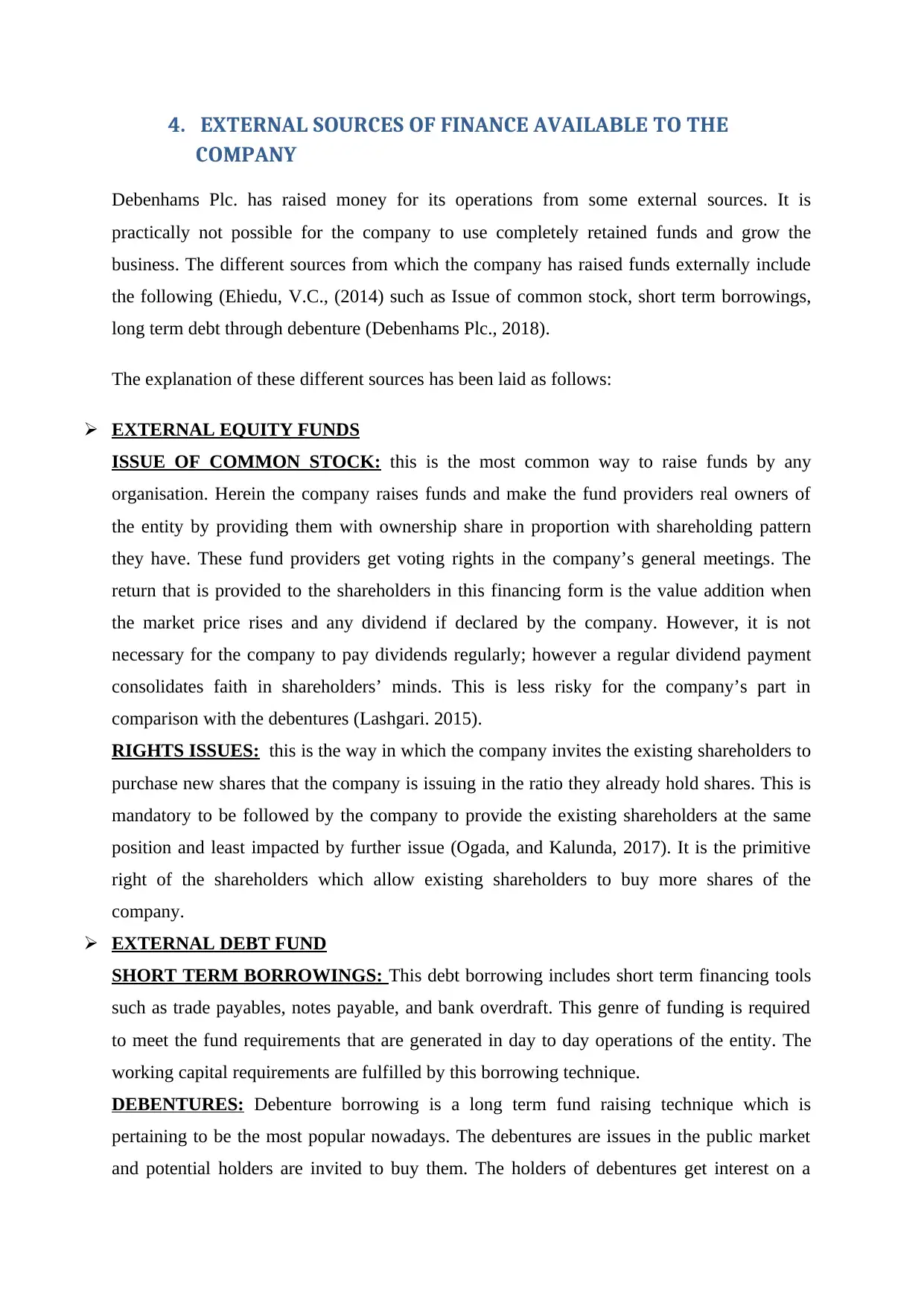
4. EXTERNAL SOURCES OF FINANCE AVAILABLE TO THE
COMPANY
Debenhams Plc. has raised money for its operations from some external sources. It is
practically not possible for the company to use completely retained funds and grow the
business. The different sources from which the company has raised funds externally include
the following (Ehiedu, V.C., (2014) such as Issue of common stock, short term borrowings,
long term debt through debenture (Debenhams Plc., 2018).
The explanation of these different sources has been laid as follows:
EXTERNAL EQUITY FUNDS
ISSUE OF COMMON STOCK: this is the most common way to raise funds by any
organisation. Herein the company raises funds and make the fund providers real owners of
the entity by providing them with ownership share in proportion with shareholding pattern
they have. These fund providers get voting rights in the company’s general meetings. The
return that is provided to the shareholders in this financing form is the value addition when
the market price rises and any dividend if declared by the company. However, it is not
necessary for the company to pay dividends regularly; however a regular dividend payment
consolidates faith in shareholders’ minds. This is less risky for the company’s part in
comparison with the debentures (Lashgari. 2015).
RIGHTS ISSUES: this is the way in which the company invites the existing shareholders to
purchase new shares that the company is issuing in the ratio they already hold shares. This is
mandatory to be followed by the company to provide the existing shareholders at the same
position and least impacted by further issue (Ogada, and Kalunda, 2017). It is the primitive
right of the shareholders which allow existing shareholders to buy more shares of the
company.
EXTERNAL DEBT FUND
SHORT TERM BORROWINGS: This debt borrowing includes short term financing tools
such as trade payables, notes payable, and bank overdraft. This genre of funding is required
to meet the fund requirements that are generated in day to day operations of the entity. The
working capital requirements are fulfilled by this borrowing technique.
DEBENTURES: Debenture borrowing is a long term fund raising technique which is
pertaining to be the most popular nowadays. The debentures are issues in the public market
and potential holders are invited to buy them. The holders of debentures get interest on a
COMPANY
Debenhams Plc. has raised money for its operations from some external sources. It is
practically not possible for the company to use completely retained funds and grow the
business. The different sources from which the company has raised funds externally include
the following (Ehiedu, V.C., (2014) such as Issue of common stock, short term borrowings,
long term debt through debenture (Debenhams Plc., 2018).
The explanation of these different sources has been laid as follows:
EXTERNAL EQUITY FUNDS
ISSUE OF COMMON STOCK: this is the most common way to raise funds by any
organisation. Herein the company raises funds and make the fund providers real owners of
the entity by providing them with ownership share in proportion with shareholding pattern
they have. These fund providers get voting rights in the company’s general meetings. The
return that is provided to the shareholders in this financing form is the value addition when
the market price rises and any dividend if declared by the company. However, it is not
necessary for the company to pay dividends regularly; however a regular dividend payment
consolidates faith in shareholders’ minds. This is less risky for the company’s part in
comparison with the debentures (Lashgari. 2015).
RIGHTS ISSUES: this is the way in which the company invites the existing shareholders to
purchase new shares that the company is issuing in the ratio they already hold shares. This is
mandatory to be followed by the company to provide the existing shareholders at the same
position and least impacted by further issue (Ogada, and Kalunda, 2017). It is the primitive
right of the shareholders which allow existing shareholders to buy more shares of the
company.
EXTERNAL DEBT FUND
SHORT TERM BORROWINGS: This debt borrowing includes short term financing tools
such as trade payables, notes payable, and bank overdraft. This genre of funding is required
to meet the fund requirements that are generated in day to day operations of the entity. The
working capital requirements are fulfilled by this borrowing technique.
DEBENTURES: Debenture borrowing is a long term fund raising technique which is
pertaining to be the most popular nowadays. The debentures are issues in the public market
and potential holders are invited to buy them. The holders of debentures get interest on a
⊘ This is a preview!⊘
Do you want full access?
Subscribe today to unlock all pages.

Trusted by 1+ million students worldwide
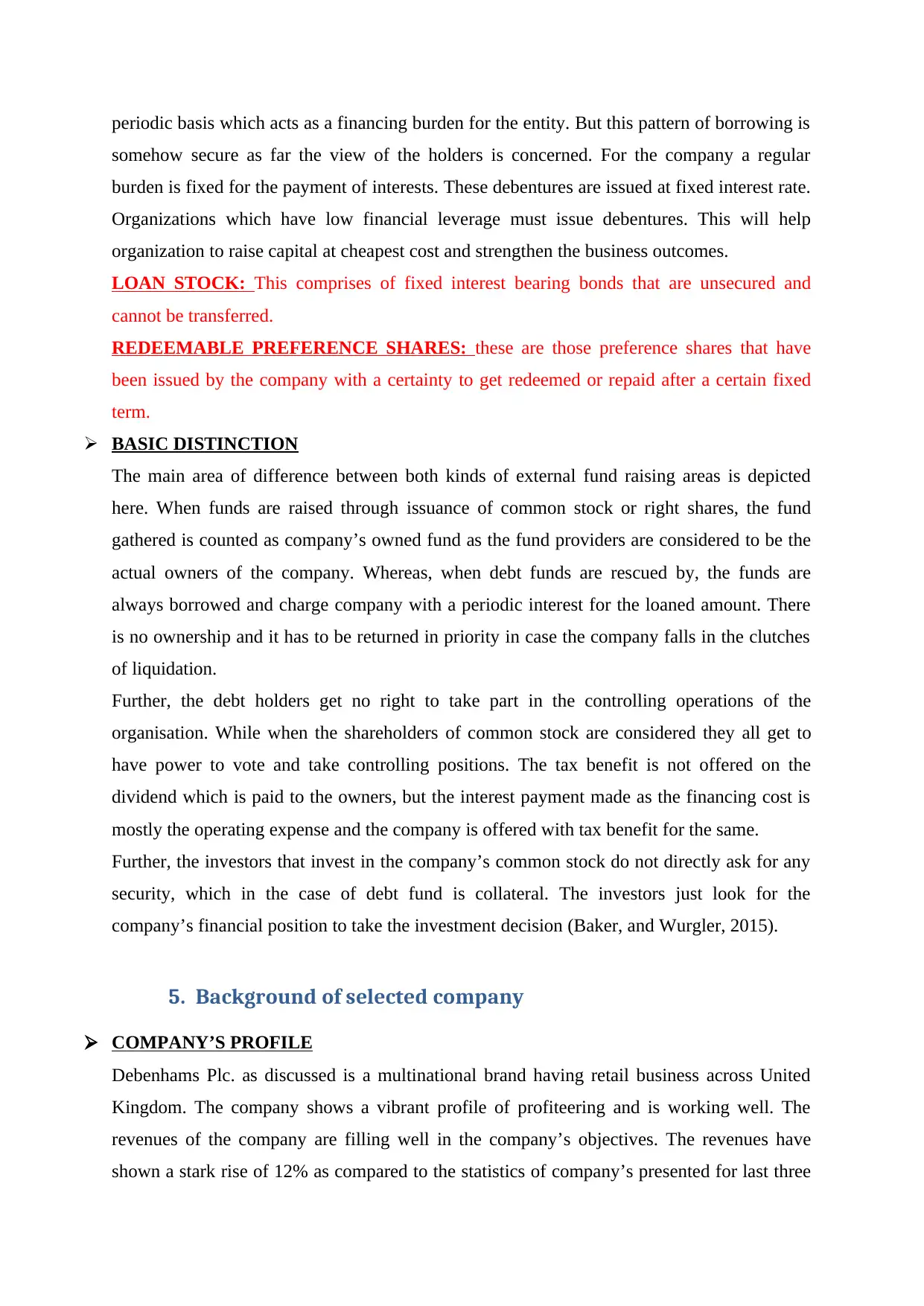
periodic basis which acts as a financing burden for the entity. But this pattern of borrowing is
somehow secure as far the view of the holders is concerned. For the company a regular
burden is fixed for the payment of interests. These debentures are issued at fixed interest rate.
Organizations which have low financial leverage must issue debentures. This will help
organization to raise capital at cheapest cost and strengthen the business outcomes.
LOAN STOCK: This comprises of fixed interest bearing bonds that are unsecured and
cannot be transferred.
REDEEMABLE PREFERENCE SHARES: these are those preference shares that have
been issued by the company with a certainty to get redeemed or repaid after a certain fixed
term.
BASIC DISTINCTION
The main area of difference between both kinds of external fund raising areas is depicted
here. When funds are raised through issuance of common stock or right shares, the fund
gathered is counted as company’s owned fund as the fund providers are considered to be the
actual owners of the company. Whereas, when debt funds are rescued by, the funds are
always borrowed and charge company with a periodic interest for the loaned amount. There
is no ownership and it has to be returned in priority in case the company falls in the clutches
of liquidation.
Further, the debt holders get no right to take part in the controlling operations of the
organisation. While when the shareholders of common stock are considered they all get to
have power to vote and take controlling positions. The tax benefit is not offered on the
dividend which is paid to the owners, but the interest payment made as the financing cost is
mostly the operating expense and the company is offered with tax benefit for the same.
Further, the investors that invest in the company’s common stock do not directly ask for any
security, which in the case of debt fund is collateral. The investors just look for the
company’s financial position to take the investment decision (Baker, and Wurgler, 2015).
5. Background of selected company
COMPANY’S PROFILE
Debenhams Plc. as discussed is a multinational brand having retail business across United
Kingdom. The company shows a vibrant profile of profiteering and is working well. The
revenues of the company are filling well in the company’s objectives. The revenues have
shown a stark rise of 12% as compared to the statistics of company’s presented for last three
somehow secure as far the view of the holders is concerned. For the company a regular
burden is fixed for the payment of interests. These debentures are issued at fixed interest rate.
Organizations which have low financial leverage must issue debentures. This will help
organization to raise capital at cheapest cost and strengthen the business outcomes.
LOAN STOCK: This comprises of fixed interest bearing bonds that are unsecured and
cannot be transferred.
REDEEMABLE PREFERENCE SHARES: these are those preference shares that have
been issued by the company with a certainty to get redeemed or repaid after a certain fixed
term.
BASIC DISTINCTION
The main area of difference between both kinds of external fund raising areas is depicted
here. When funds are raised through issuance of common stock or right shares, the fund
gathered is counted as company’s owned fund as the fund providers are considered to be the
actual owners of the company. Whereas, when debt funds are rescued by, the funds are
always borrowed and charge company with a periodic interest for the loaned amount. There
is no ownership and it has to be returned in priority in case the company falls in the clutches
of liquidation.
Further, the debt holders get no right to take part in the controlling operations of the
organisation. While when the shareholders of common stock are considered they all get to
have power to vote and take controlling positions. The tax benefit is not offered on the
dividend which is paid to the owners, but the interest payment made as the financing cost is
mostly the operating expense and the company is offered with tax benefit for the same.
Further, the investors that invest in the company’s common stock do not directly ask for any
security, which in the case of debt fund is collateral. The investors just look for the
company’s financial position to take the investment decision (Baker, and Wurgler, 2015).
5. Background of selected company
COMPANY’S PROFILE
Debenhams Plc. as discussed is a multinational brand having retail business across United
Kingdom. The company shows a vibrant profile of profiteering and is working well. The
revenues of the company are filling well in the company’s objectives. The revenues have
shown a stark rise of 12% as compared to the statistics of company’s presented for last three
Paraphrase This Document
Need a fresh take? Get an instant paraphrase of this document with our AI Paraphraser
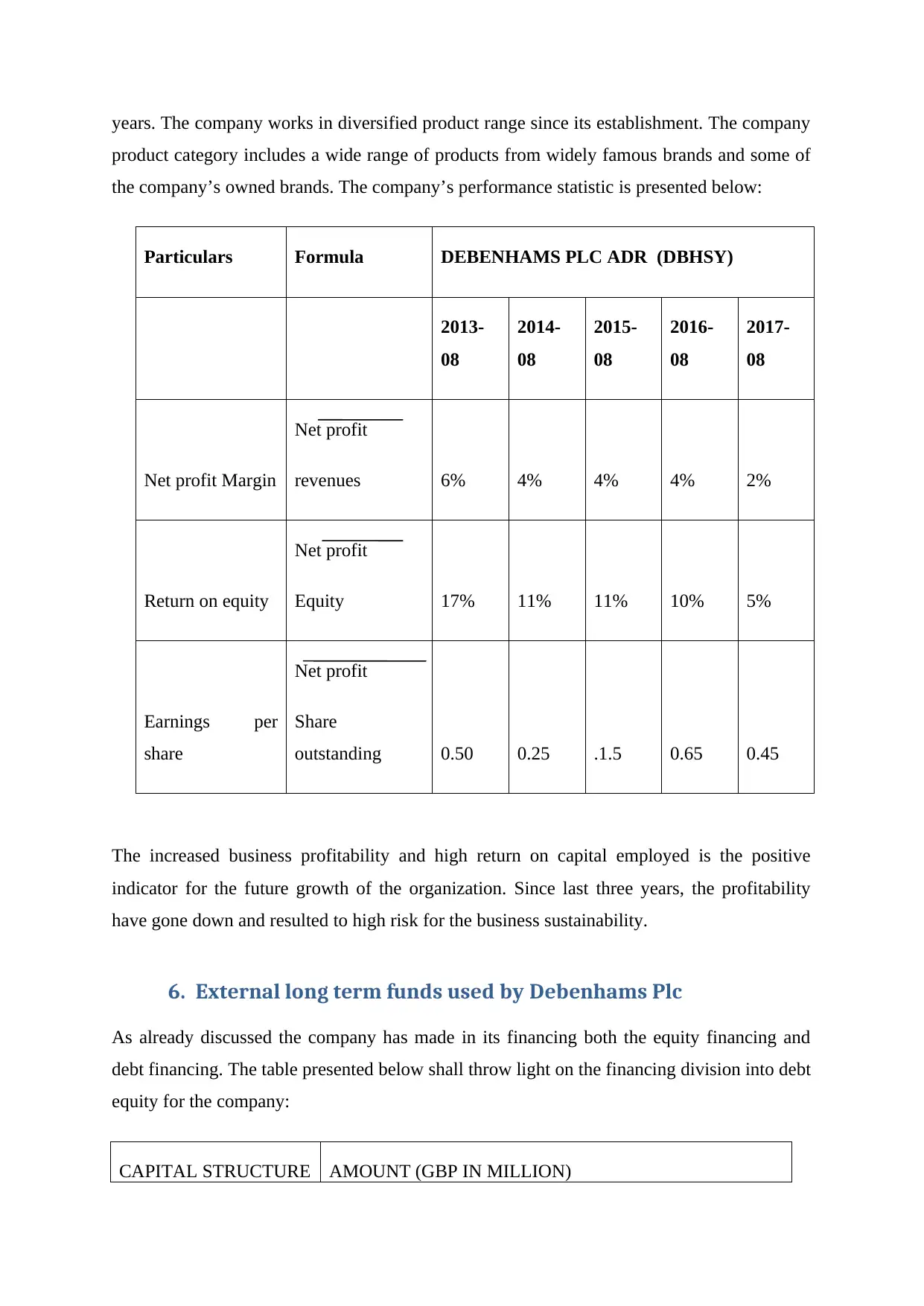
years. The company works in diversified product range since its establishment. The company
product category includes a wide range of products from widely famous brands and some of
the company’s owned brands. The company’s performance statistic is presented below:
Particulars Formula DEBENHAMS PLC ADR (DBHSY)
2013-
08
2014-
08
2015-
08
2016-
08
2017-
08
Net profit Margin
Net profit
revenues 6% 4% 4% 4% 2%
Return on equity
Net profit
Equity 17% 11% 11% 10% 5%
Earnings per
share
Net profit
Share
outstanding 0.50 0.25 .1.5 0.65 0.45
The increased business profitability and high return on capital employed is the positive
indicator for the future growth of the organization. Since last three years, the profitability
have gone down and resulted to high risk for the business sustainability.
6. External long term funds used by Debenhams Plc
As already discussed the company has made in its financing both the equity financing and
debt financing. The table presented below shall throw light on the financing division into debt
equity for the company:
CAPITAL STRUCTURE AMOUNT (GBP IN MILLION)
product category includes a wide range of products from widely famous brands and some of
the company’s owned brands. The company’s performance statistic is presented below:
Particulars Formula DEBENHAMS PLC ADR (DBHSY)
2013-
08
2014-
08
2015-
08
2016-
08
2017-
08
Net profit Margin
Net profit
revenues 6% 4% 4% 4% 2%
Return on equity
Net profit
Equity 17% 11% 11% 10% 5%
Earnings per
share
Net profit
Share
outstanding 0.50 0.25 .1.5 0.65 0.45
The increased business profitability and high return on capital employed is the positive
indicator for the future growth of the organization. Since last three years, the profitability
have gone down and resulted to high risk for the business sustainability.
6. External long term funds used by Debenhams Plc
As already discussed the company has made in its financing both the equity financing and
debt financing. The table presented below shall throw light on the financing division into debt
equity for the company:
CAPITAL STRUCTURE AMOUNT (GBP IN MILLION)
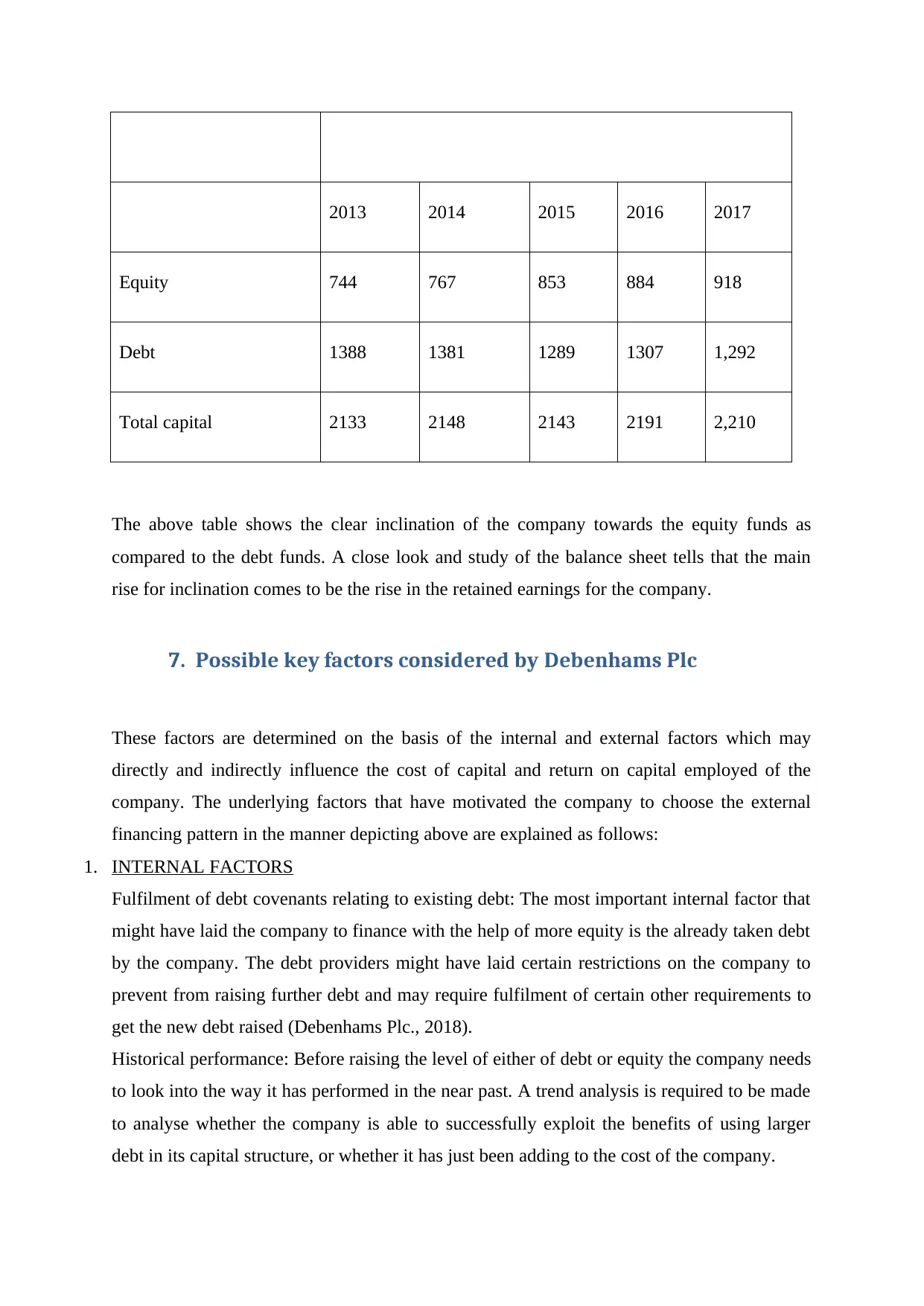
2013 2014 2015 2016 2017
Equity 744 767 853 884 918
Debt 1388 1381 1289 1307 1,292
Total capital 2133 2148 2143 2191 2,210
The above table shows the clear inclination of the company towards the equity funds as
compared to the debt funds. A close look and study of the balance sheet tells that the main
rise for inclination comes to be the rise in the retained earnings for the company.
7. Possible key factors considered by Debenhams Plc
These factors are determined on the basis of the internal and external factors which may
directly and indirectly influence the cost of capital and return on capital employed of the
company. The underlying factors that have motivated the company to choose the external
financing pattern in the manner depicting above are explained as follows:
1. INTERNAL FACTORS
Fulfilment of debt covenants relating to existing debt: The most important internal factor that
might have laid the company to finance with the help of more equity is the already taken debt
by the company. The debt providers might have laid certain restrictions on the company to
prevent from raising further debt and may require fulfilment of certain other requirements to
get the new debt raised (Debenhams Plc., 2018).
Historical performance: Before raising the level of either of debt or equity the company needs
to look into the way it has performed in the near past. A trend analysis is required to be made
to analyse whether the company is able to successfully exploit the benefits of using larger
debt in its capital structure, or whether it has just been adding to the cost of the company.
Equity 744 767 853 884 918
Debt 1388 1381 1289 1307 1,292
Total capital 2133 2148 2143 2191 2,210
The above table shows the clear inclination of the company towards the equity funds as
compared to the debt funds. A close look and study of the balance sheet tells that the main
rise for inclination comes to be the rise in the retained earnings for the company.
7. Possible key factors considered by Debenhams Plc
These factors are determined on the basis of the internal and external factors which may
directly and indirectly influence the cost of capital and return on capital employed of the
company. The underlying factors that have motivated the company to choose the external
financing pattern in the manner depicting above are explained as follows:
1. INTERNAL FACTORS
Fulfilment of debt covenants relating to existing debt: The most important internal factor that
might have laid the company to finance with the help of more equity is the already taken debt
by the company. The debt providers might have laid certain restrictions on the company to
prevent from raising further debt and may require fulfilment of certain other requirements to
get the new debt raised (Debenhams Plc., 2018).
Historical performance: Before raising the level of either of debt or equity the company needs
to look into the way it has performed in the near past. A trend analysis is required to be made
to analyse whether the company is able to successfully exploit the benefits of using larger
debt in its capital structure, or whether it has just been adding to the cost of the company.
⊘ This is a preview!⊘
Do you want full access?
Subscribe today to unlock all pages.

Trusted by 1+ million students worldwide
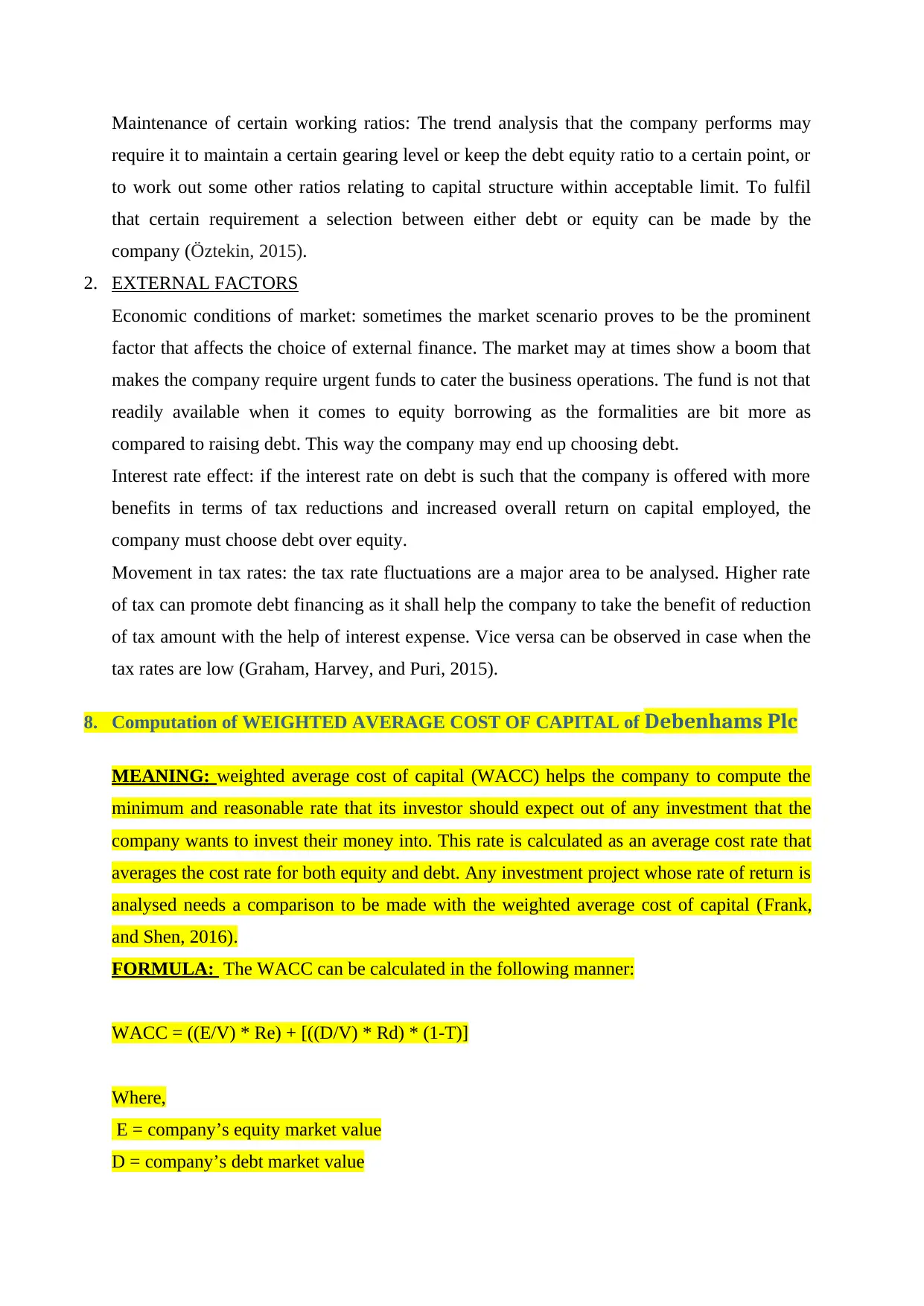
Maintenance of certain working ratios: The trend analysis that the company performs may
require it to maintain a certain gearing level or keep the debt equity ratio to a certain point, or
to work out some other ratios relating to capital structure within acceptable limit. To fulfil
that certain requirement a selection between either debt or equity can be made by the
company (Öztekin, 2015).
2. EXTERNAL FACTORS
Economic conditions of market: sometimes the market scenario proves to be the prominent
factor that affects the choice of external finance. The market may at times show a boom that
makes the company require urgent funds to cater the business operations. The fund is not that
readily available when it comes to equity borrowing as the formalities are bit more as
compared to raising debt. This way the company may end up choosing debt.
Interest rate effect: if the interest rate on debt is such that the company is offered with more
benefits in terms of tax reductions and increased overall return on capital employed, the
company must choose debt over equity.
Movement in tax rates: the tax rate fluctuations are a major area to be analysed. Higher rate
of tax can promote debt financing as it shall help the company to take the benefit of reduction
of tax amount with the help of interest expense. Vice versa can be observed in case when the
tax rates are low (Graham, Harvey, and Puri, 2015).
8. Computation of WEIGHTED AVERAGE COST OF CAPITAL of Debenhams Plc
MEANING: weighted average cost of capital (WACC) helps the company to compute the
minimum and reasonable rate that its investor should expect out of any investment that the
company wants to invest their money into. This rate is calculated as an average cost rate that
averages the cost rate for both equity and debt. Any investment project whose rate of return is
analysed needs a comparison to be made with the weighted average cost of capital (Frank,
and Shen, 2016).
FORMULA: The WACC can be calculated in the following manner:
WACC = ((E/V) * Re) + [((D/V) * Rd) * (1-T)]
Where,
E = company’s equity market value
D = company’s debt market value
require it to maintain a certain gearing level or keep the debt equity ratio to a certain point, or
to work out some other ratios relating to capital structure within acceptable limit. To fulfil
that certain requirement a selection between either debt or equity can be made by the
company (Öztekin, 2015).
2. EXTERNAL FACTORS
Economic conditions of market: sometimes the market scenario proves to be the prominent
factor that affects the choice of external finance. The market may at times show a boom that
makes the company require urgent funds to cater the business operations. The fund is not that
readily available when it comes to equity borrowing as the formalities are bit more as
compared to raising debt. This way the company may end up choosing debt.
Interest rate effect: if the interest rate on debt is such that the company is offered with more
benefits in terms of tax reductions and increased overall return on capital employed, the
company must choose debt over equity.
Movement in tax rates: the tax rate fluctuations are a major area to be analysed. Higher rate
of tax can promote debt financing as it shall help the company to take the benefit of reduction
of tax amount with the help of interest expense. Vice versa can be observed in case when the
tax rates are low (Graham, Harvey, and Puri, 2015).
8. Computation of WEIGHTED AVERAGE COST OF CAPITAL of Debenhams Plc
MEANING: weighted average cost of capital (WACC) helps the company to compute the
minimum and reasonable rate that its investor should expect out of any investment that the
company wants to invest their money into. This rate is calculated as an average cost rate that
averages the cost rate for both equity and debt. Any investment project whose rate of return is
analysed needs a comparison to be made with the weighted average cost of capital (Frank,
and Shen, 2016).
FORMULA: The WACC can be calculated in the following manner:
WACC = ((E/V) * Re) + [((D/V) * Rd) * (1-T)]
Where,
E = company’s equity market value
D = company’s debt market value
Paraphrase This Document
Need a fresh take? Get an instant paraphrase of this document with our AI Paraphraser
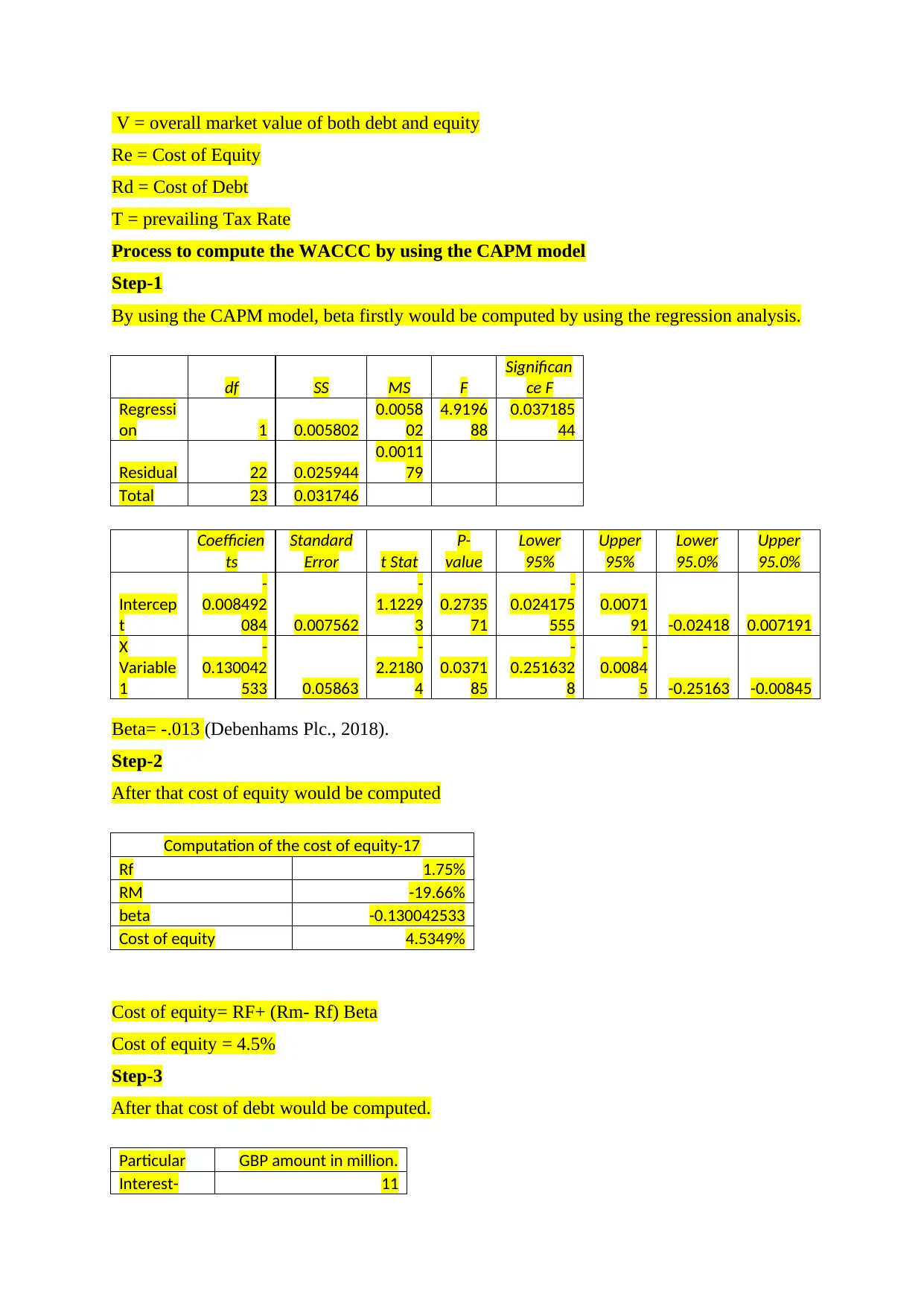
V = overall market value of both debt and equity
Re = Cost of Equity
Rd = Cost of Debt
T = prevailing Tax Rate
Process to compute the WACCC by using the CAPM model
Step-1
By using the CAPM model, beta firstly would be computed by using the regression analysis.
df SS MS F
Significan
ce F
Regressi
on 1 0.005802
0.0058
02
4.9196
88
0.037185
44
Residual 22 0.025944
0.0011
79
Total 23 0.031746
Coefficien
ts
Standard
Error t Stat
P-
value
Lower
95%
Upper
95%
Lower
95.0%
Upper
95.0%
Intercep
t
-
0.008492
084 0.007562
-
1.1229
3
0.2735
71
-
0.024175
555
0.0071
91 -0.02418 0.007191
X
Variable
1
-
0.130042
533 0.05863
-
2.2180
4
0.0371
85
-
0.251632
8
-
0.0084
5 -0.25163 -0.00845
Beta= -.013 (Debenhams Plc., 2018).
Step-2
After that cost of equity would be computed
Computation of the cost of equity-17
Rf 1.75%
RM -19.66%
beta -0.130042533
Cost of equity 4.5349%
Cost of equity= RF+ (Rm- Rf) Beta
Cost of equity = 4.5%
Step-3
After that cost of debt would be computed.
Particular GBP amount in million.
Interest- 11
Re = Cost of Equity
Rd = Cost of Debt
T = prevailing Tax Rate
Process to compute the WACCC by using the CAPM model
Step-1
By using the CAPM model, beta firstly would be computed by using the regression analysis.
df SS MS F
Significan
ce F
Regressi
on 1 0.005802
0.0058
02
4.9196
88
0.037185
44
Residual 22 0.025944
0.0011
79
Total 23 0.031746
Coefficien
ts
Standard
Error t Stat
P-
value
Lower
95%
Upper
95%
Lower
95.0%
Upper
95.0%
Intercep
t
-
0.008492
084 0.007562
-
1.1229
3
0.2735
71
-
0.024175
555
0.0071
91 -0.02418 0.007191
X
Variable
1
-
0.130042
533 0.05863
-
2.2180
4
0.0371
85
-
0.251632
8
-
0.0084
5 -0.25163 -0.00845
Beta= -.013 (Debenhams Plc., 2018).
Step-2
After that cost of equity would be computed
Computation of the cost of equity-17
Rf 1.75%
RM -19.66%
beta -0.130042533
Cost of equity 4.5349%
Cost of equity= RF+ (Rm- Rf) Beta
Cost of equity = 4.5%
Step-3
After that cost of debt would be computed.
Particular GBP amount in million.
Interest- 11
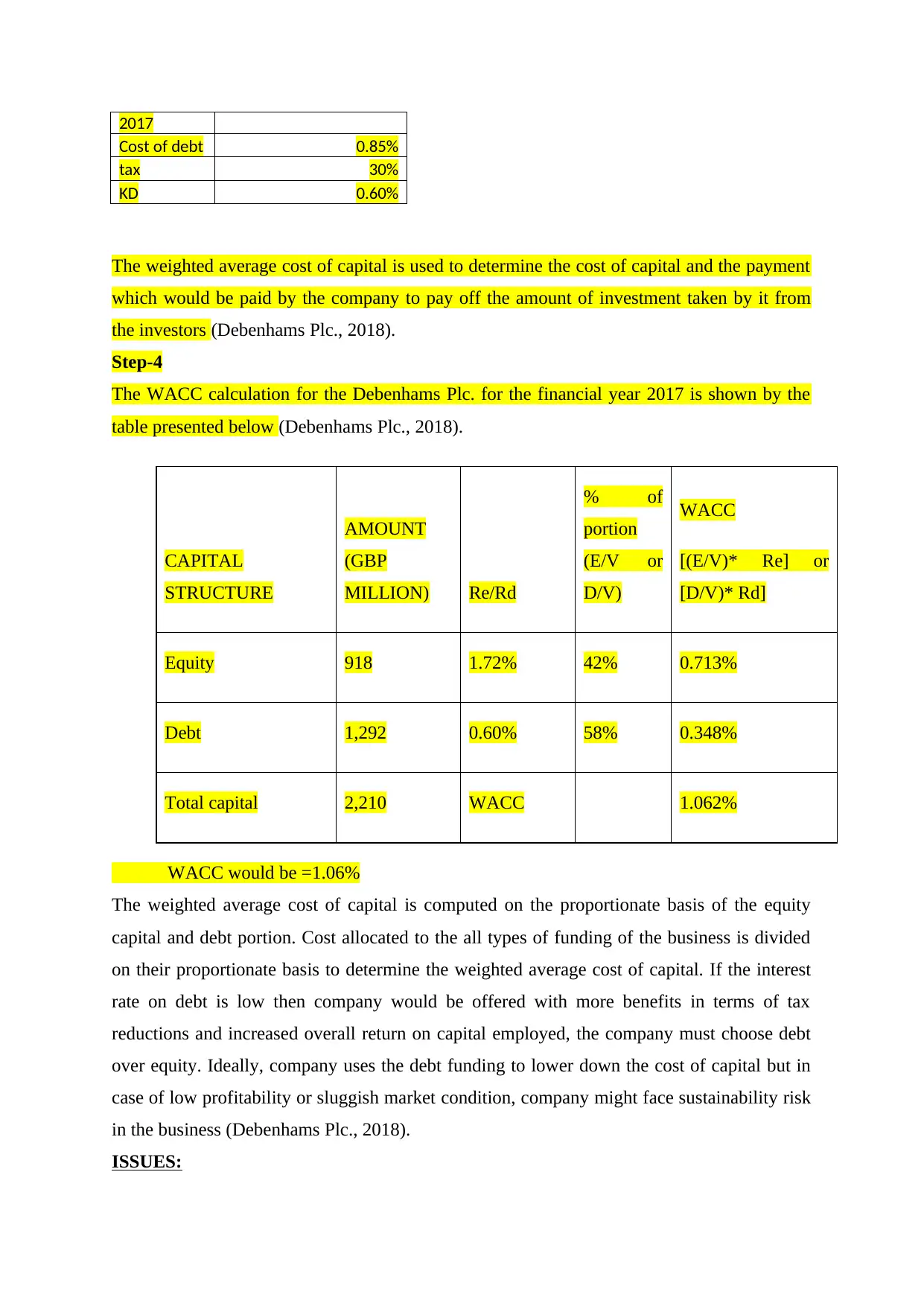
2017
Cost of debt 0.85%
tax 30%
KD 0.60%
The weighted average cost of capital is used to determine the cost of capital and the payment
which would be paid by the company to pay off the amount of investment taken by it from
the investors (Debenhams Plc., 2018).
Step-4
The WACC calculation for the Debenhams Plc. for the financial year 2017 is shown by the
table presented below (Debenhams Plc., 2018).
CAPITAL
STRUCTURE
AMOUNT
(GBP
MILLION) Re/Rd
% of
portion
(E/V or
D/V)
WACC
[(E/V)* Re] or
[D/V)* Rd]
Equity 918 1.72% 42% 0.713%
Debt 1,292 0.60% 58% 0.348%
Total capital 2,210 WACC 1.062%
WACC would be =1.06%
The weighted average cost of capital is computed on the proportionate basis of the equity
capital and debt portion. Cost allocated to the all types of funding of the business is divided
on their proportionate basis to determine the weighted average cost of capital. If the interest
rate on debt is low then company would be offered with more benefits in terms of tax
reductions and increased overall return on capital employed, the company must choose debt
over equity. Ideally, company uses the debt funding to lower down the cost of capital but in
case of low profitability or sluggish market condition, company might face sustainability risk
in the business (Debenhams Plc., 2018).
ISSUES:
Cost of debt 0.85%
tax 30%
KD 0.60%
The weighted average cost of capital is used to determine the cost of capital and the payment
which would be paid by the company to pay off the amount of investment taken by it from
the investors (Debenhams Plc., 2018).
Step-4
The WACC calculation for the Debenhams Plc. for the financial year 2017 is shown by the
table presented below (Debenhams Plc., 2018).
CAPITAL
STRUCTURE
AMOUNT
(GBP
MILLION) Re/Rd
% of
portion
(E/V or
D/V)
WACC
[(E/V)* Re] or
[D/V)* Rd]
Equity 918 1.72% 42% 0.713%
Debt 1,292 0.60% 58% 0.348%
Total capital 2,210 WACC 1.062%
WACC would be =1.06%
The weighted average cost of capital is computed on the proportionate basis of the equity
capital and debt portion. Cost allocated to the all types of funding of the business is divided
on their proportionate basis to determine the weighted average cost of capital. If the interest
rate on debt is low then company would be offered with more benefits in terms of tax
reductions and increased overall return on capital employed, the company must choose debt
over equity. Ideally, company uses the debt funding to lower down the cost of capital but in
case of low profitability or sluggish market condition, company might face sustainability risk
in the business (Debenhams Plc., 2018).
ISSUES:
⊘ This is a preview!⊘
Do you want full access?
Subscribe today to unlock all pages.

Trusted by 1+ million students worldwide
1 out of 19
Related Documents
Your All-in-One AI-Powered Toolkit for Academic Success.
+13062052269
info@desklib.com
Available 24*7 on WhatsApp / Email
![[object Object]](/_next/static/media/star-bottom.7253800d.svg)
Unlock your academic potential
Copyright © 2020–2025 A2Z Services. All Rights Reserved. Developed and managed by ZUCOL.



